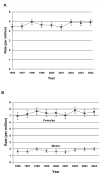Changes in the incidence of endstage renal disease due to lupus nephritis in the United States, 1996-2004
- PMID: 19004042
- PMCID: PMC2679678
- DOI: 10.3899/jrheum.080625
Changes in the incidence of endstage renal disease due to lupus nephritis in the United States, 1996-2004
Abstract
Objective: To determine if the incidence of endstage renal disease (ESRD) due to lupus nephritis has decreased from 1996 to 2004.
Methods: Patients age 15 years or older with incident ESRD due to lupus nephritis in 1996-2004 and living in one of the 50 United States or the District of Columbia were identified using the US Renal Data System, a national population-based registry of all patients receiving renal replacement therapy for ESRD. Incidence rates were computed for each calendar year, using population estimates of the US census as denominators.
Results: Over the 9-year study period, 9199 new cases of ESRD due to lupus nephritis were observed. Incidence rates, adjusted to the age, sex, and race composition of the US population in 2000, were 4.4 per million in 1996 and 4.9 per million in 2004. Compared to the pooled incidence rate in 1996-1998, the relative risk of ESRD due to lupus nephritis in 1999-2000 was 0.99 (95% CI 0.93-1.06), in 2001-2002 was 0.99 (95% CI 0.92-1.06), and in 2003-2004 was 0.96 (95% CI 0.89-1.02). Findings were similar in analyses stratified by sex, age group, race, and socioeconomic status.
Conclusion: There was no decrease in the incidence of ESRD due to lupus nephritis between 1996 and 2004. This may reflect the limits of effectiveness of current treatments, or limitations in access, use, or adherence to treatment.
Figures



References
-
- Ward MM. Changes in the incidence of end-stage renal disease due to lupus nephritis, 1982-1995. Arch Intern Med. 2000;160:3136–40. - PubMed
-
- United States Renal Data System . USRDS 2005 Annual Data Report: Atlas of End-stage Renal Disease in the United States. National Institutes of Health, National Institute of Diabetes and Digestive and Kidney Diseases; Bethesda, MD: 2005.
-
- Ward MM. Socioeconomic status and the incidence of ESRD. Am J Kidney Dis. 2008;51:563–72. - PubMed
-
- U.S. Census Bureau Population Estimates at:http://www.census.gov/popest/datasets.html
Publication types
MeSH terms
Grants and funding
LinkOut - more resources
Full Text Sources
Medical
